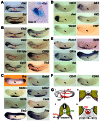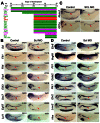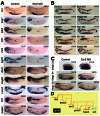VEGFA-dependent and -independent pathways synergise to drive Scl expression and initiate programming of the blood stem cell lineage in Xenopus
- PMID: 23637333
- PMCID: PMC3666388
- DOI: 10.1242/dev.090829
VEGFA-dependent and -independent pathways synergise to drive Scl expression and initiate programming of the blood stem cell lineage in Xenopus
Abstract
The first haematopoietic stem cells share a common origin with the dorsal aorta and derive from putative adult haemangioblasts in the dorsal lateral plate (DLP) mesoderm. Here we show that the transcription factor (TF) stem cell leukaemia (Scl/Tal1) is crucial for development of these adult haemangioblasts in Xenopus and establish the regulatory cascade controlling its expression. We show that VEGFA produced in the somites is required to initiate adult haemangioblast programming in the adjacent DLP by establishing endogenous VEGFA signalling. This response depends on expression of the VEGF receptor Flk1, driven by Fli1 and Gata2. Scl activation requires synergy between this VEGFA-controlled pathway and a VEGFA-independent pathway controlled by Fli1, Gata2 and Etv2/Etsrp/ER71, which also drives expression of the Scl partner Lmo2. Thus, the two ETS factors Fli1 and Etv6, which drives the VEGFA expression in both somites and the DLP, sit at the top of the adult haemangioblast gene regulatory network (GRN). Furthermore, Gata2 is initially activated by Fli1 but later maintained by another ETS factor, Etv2. We also establish that Flk1 and Etv2 act independently in the two pathways to Scl activation. Thus, detailed temporal, epistatic measurements of key TFs and VEGFA plus its receptor have enabled us to build a Xenopus adult haemangioblast GRN.
Keywords: ETS; Gene regulatory network; Haemangioblast; Haematopoietic stem cell; Scl; VEGF.
Figures





Similar articles
-
Etv6 activates vegfa expression through positive and negative transcriptional regulatory networks in Xenopus embryos.Nat Commun. 2019 Mar 6;10(1):1083. doi: 10.1038/s41467-019-09050-y. Nat Commun. 2019. PMID: 30842454 Free PMC article.
-
Gene Regulatory Networks Governing the Generation and Regeneration of Blood.J Comput Biol. 2019 Jul;26(7):719-725. doi: 10.1089/cmb.2019.0114. Epub 2019 May 29. J Comput Biol. 2019. PMID: 31140835
-
Fli1 acts at the top of the transcriptional network driving blood and endothelial development.Curr Biol. 2008 Aug 26;18(16):1234-40. doi: 10.1016/j.cub.2008.07.048. Curr Biol. 2008. PMID: 18718762
-
ETS Transcription Factor ETV2/ER71/Etsrp in Hematopoietic and Vascular Development.Curr Top Dev Biol. 2016;118:77-111. doi: 10.1016/bs.ctdb.2016.01.005. Epub 2016 Feb 12. Curr Top Dev Biol. 2016. PMID: 27137655 Review.
-
SCL/TAL1 in Hematopoiesis and Cellular Reprogramming.Curr Top Dev Biol. 2016;118:163-204. doi: 10.1016/bs.ctdb.2016.01.004. Epub 2016 Feb 18. Curr Top Dev Biol. 2016. PMID: 27137657 Review.
Cited by
-
New methods for computational decomposition of whole-mount in situ images enable effective curation of a large, highly redundant collection of Xenopus images.PLoS Comput Biol. 2018 Aug 29;14(8):e1006077. doi: 10.1371/journal.pcbi.1006077. eCollection 2018 Aug. PLoS Comput Biol. 2018. PMID: 30157169 Free PMC article.
-
Induction of developmental hematopoiesis mediated by transcription factors and the hematopoietic microenvironment.Ann N Y Acad Sci. 2020 Apr;1466(1):59-72. doi: 10.1111/nyas.14246. Epub 2019 Oct 17. Ann N Y Acad Sci. 2020. PMID: 31621095 Free PMC article. Review.
-
Transcription Factor TAL1 in Erythropoiesis.Adv Exp Med Biol. 2024;1459:243-258. doi: 10.1007/978-3-031-62731-6_11. Adv Exp Med Biol. 2024. PMID: 39017847 Review.
-
A Bird's Eye View on the Origin of Aortic Hemogenic Endothelial Cells.Front Cell Dev Biol. 2020 Nov 17;8:605274. doi: 10.3389/fcell.2020.605274. eCollection 2020. Front Cell Dev Biol. 2020. PMID: 33330505 Free PMC article.
-
A distinct mechanism of vascular lumen formation in Xenopus requires EGFL7.PLoS One. 2015 Feb 23;10(2):e0116086. doi: 10.1371/journal.pone.0116086. eCollection 2015. PLoS One. 2015. PMID: 25705891 Free PMC article.
References
-
- Afouda B. A., Ciau-Uitz A., Patient R. (2005). GATA4, 5 and 6 mediate TGFbeta maintenance of endodermal gene expression in Xenopus embryos. Development 132, 763-774 - PubMed
-
- Bertwistle D., Walmsley M. E., Read E. M., Pizzey J. A., Patient R. K. (1996). GATA factors and the origins of adult and embryonic blood in Xenopus: responses to retinoic acid. Mech. Dev. 57, 199-214 - PubMed
-
- Chung Y. S., Zhang W. J., Arentson E., Kingsley P. D., Palis J., Choi K. (2002). Lineage analysis of the hemangioblast as defined by FLK1 and SCL expression. Development 129, 5511-5520 - PubMed
-
- Ciau-Uitz A., Walmsley M., Patient R. (2000). Distinct origins of adult and embryonic blood in Xenopus. Cell 102, 787-796 - PubMed
-
- Ciau-Uitz A., Liu F., Patient R. (2010a). Genetic control of hematopoietic development in Xenopus and zebrafish. Int. J. Dev. Biol. 54, 1139-1149 - PubMed
Publication types
MeSH terms
Substances
Grants and funding
LinkOut - more resources
Full Text Sources
Other Literature Sources
Research Materials
Miscellaneous

